Slash Commands
Slash Commands Reference
Ohlala SmartOps includes several built-in slash commands that provide quick access to common operations and information.
/ and provide instant responses. Use them for quick tasks and information lookup.🚀 Essential Commands
/help
Purpose: Display all available commands and features
Usage:
/help
/help [command] - Show detailed help for specific command
Response: Interactive adaptive card showing:
- All available slash commands
- Natural language command examples
- Quick action buttons for common operations
- Localized content based on user’s Teams language

/instances
Purpose: List all EC2 instances with interactive management options
Usage:
/instances
Response: Interactive card displaying:
- Instance IDs, names, and tags
- Current state (running, stopped, etc.)
- Instance type and platform
- SSM connectivity status
- Quick action buttons for each instance
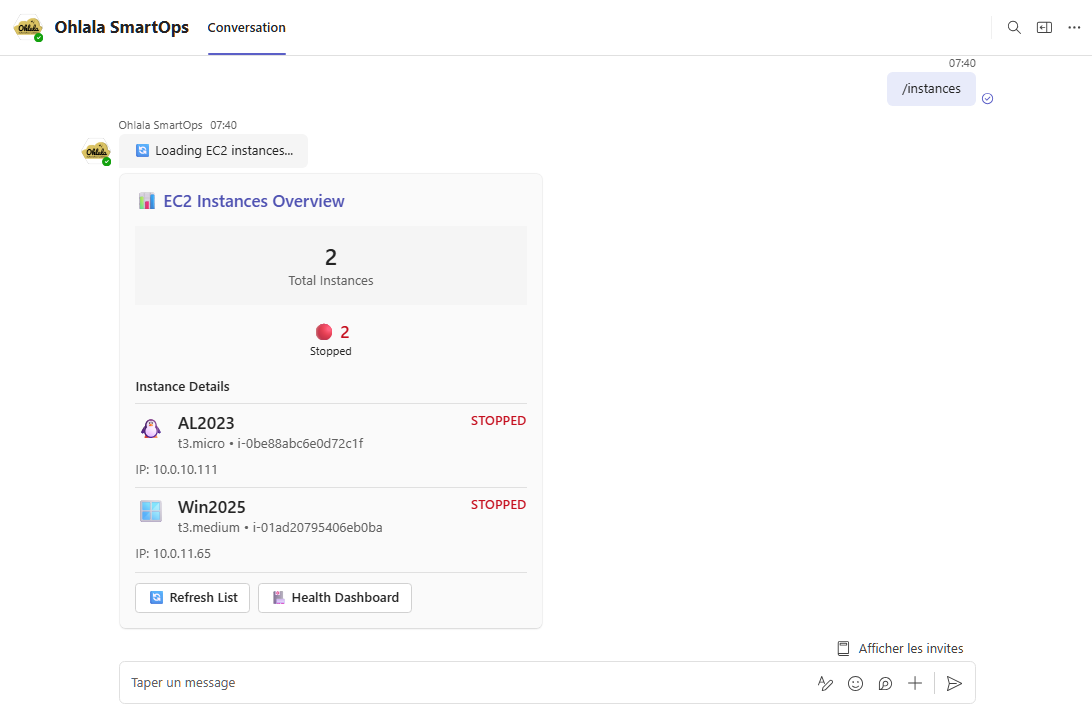
/health
Purpose: Comprehensive health dashboard for instances
Usage:
/health - Show health dashboard for all instances
/health [instance-id] - Show health for specific instance
Response: Rich dashboard featuring:
- CPU, memory, and disk usage metrics
- SSM agent connectivity status
- Visual health indicators and charts
- System performance trends
- CloudWatch metrics integration
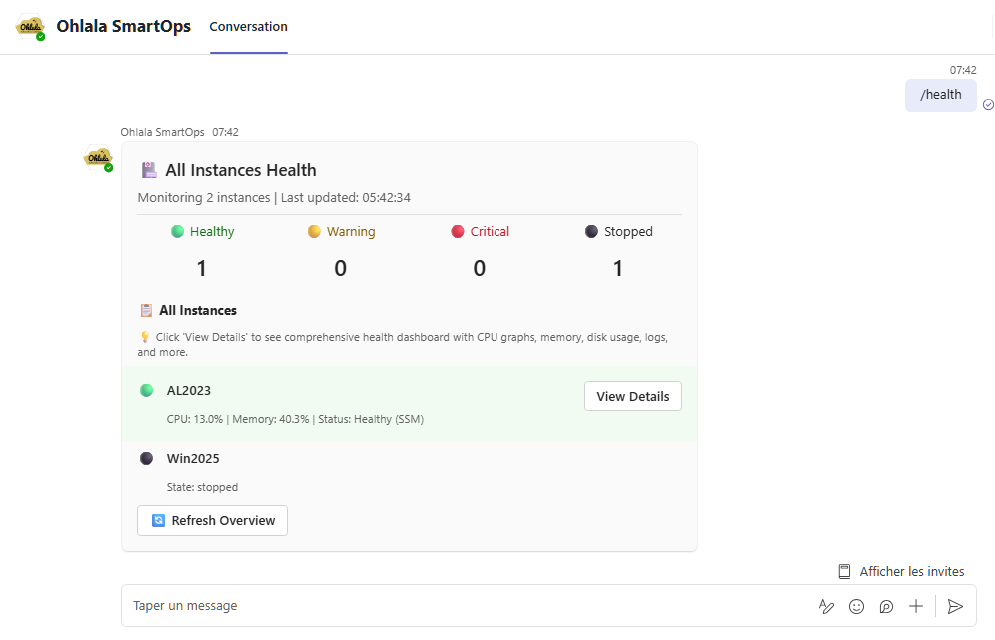
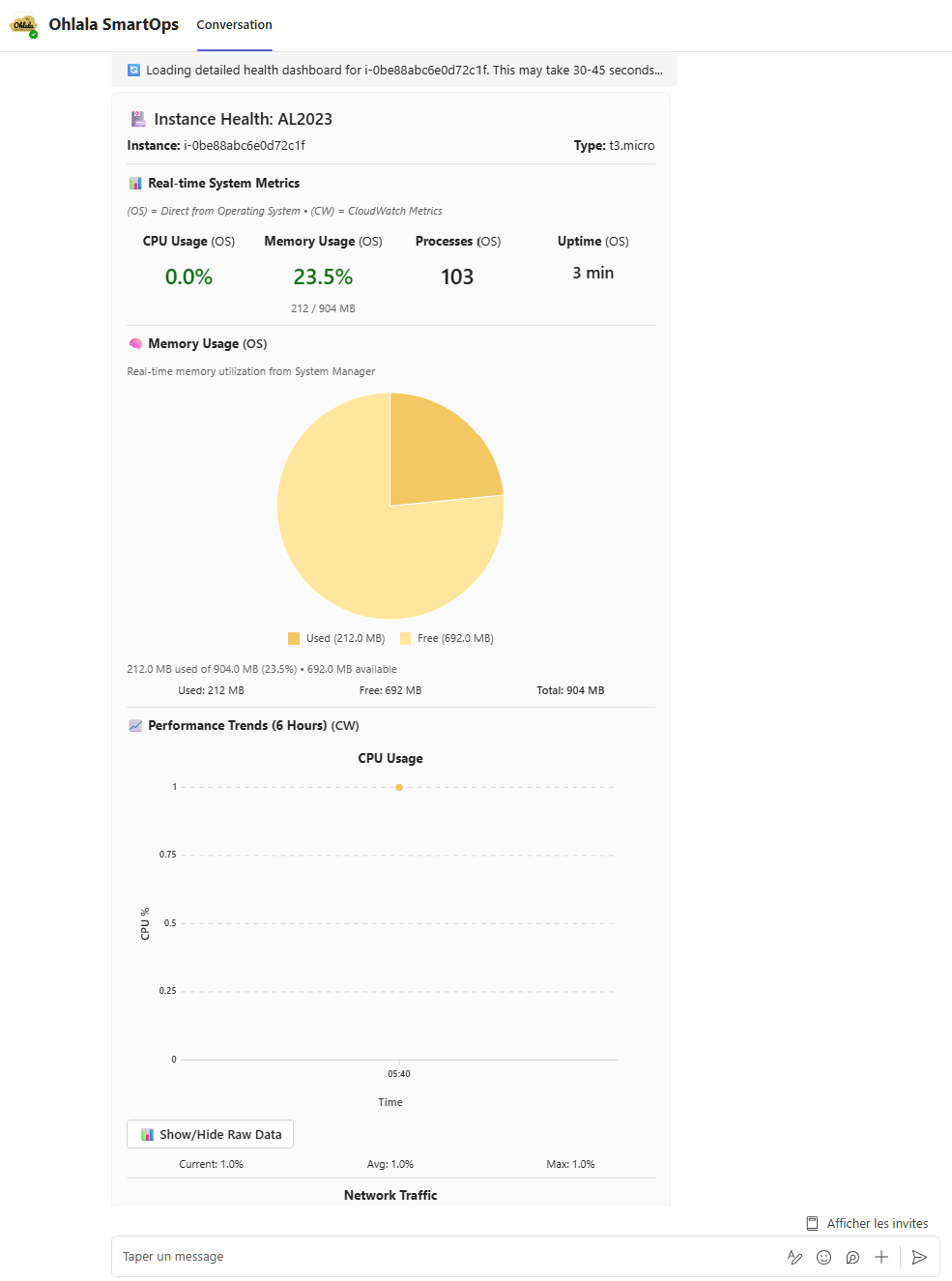
/rightsizing
Purpose: Cost optimization and rightsizing recommendations
Usage:
/rightsizing
Response: Cost optimization dashboard with:
- Current instance utilization analysis
- Rightsizing recommendations
- Potential cost savings calculations
- Instance type upgrade/downgrade suggestions
- CloudWatch metrics-based insights
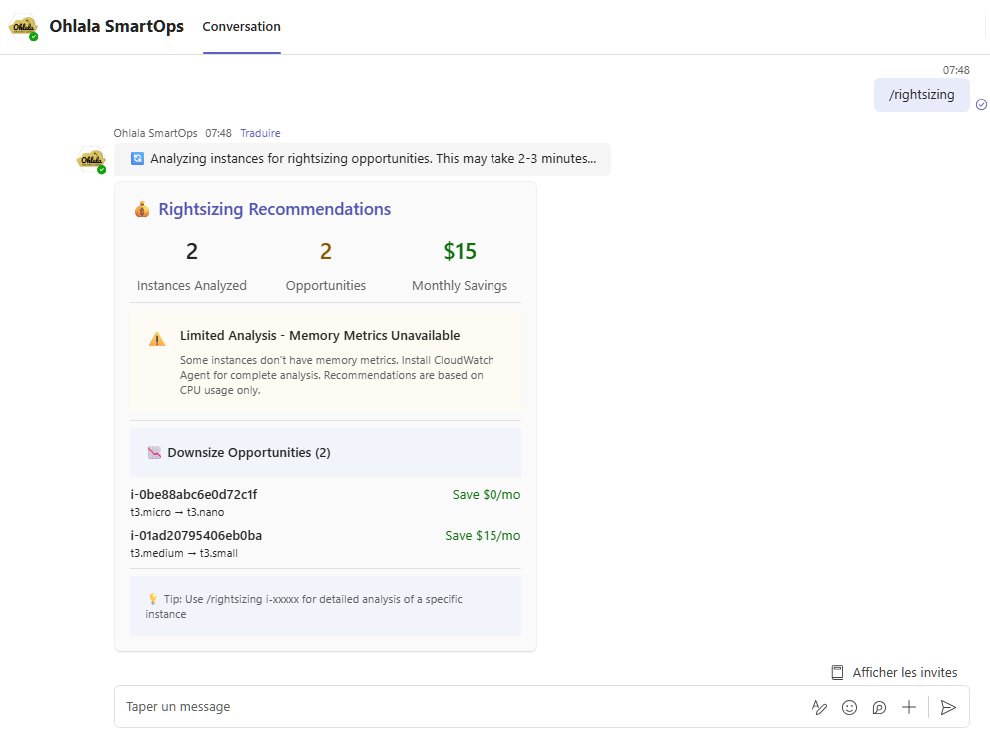
📊 Monitoring & Management Commands
/status
Purpose: Show pending commands and recent activity
Usage:
/status
Response: Command status dashboard showing:
- Currently pending SSM commands
- Recent command execution history
- Command success/failure rates
- AWS Console links for detailed monitoring
- Elapsed time for running operations
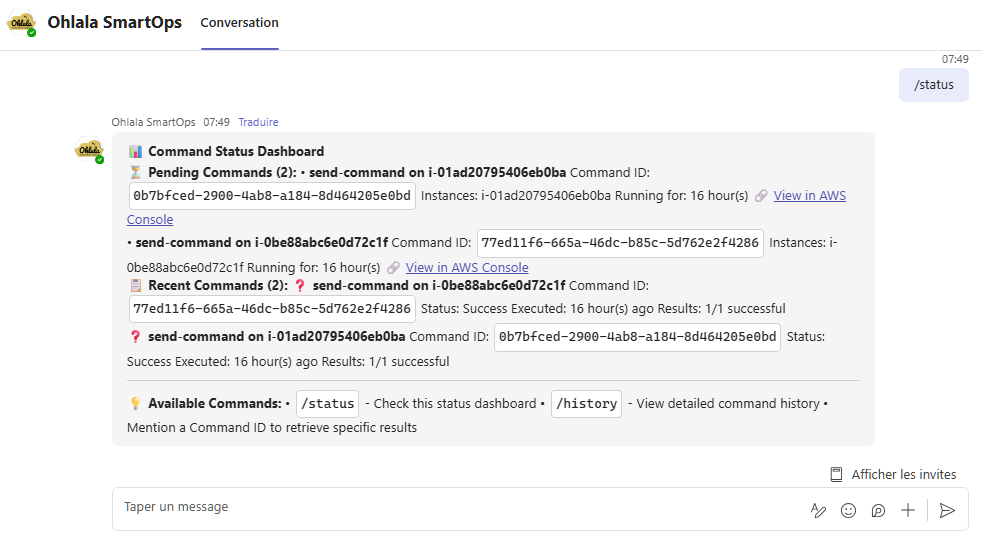
/history
Purpose: View detailed command execution history
Usage:
/history
Response: Comprehensive command history with:
- Past command executions
- Success/failure status
- Detailed results and outputs
- Timestamp and user information
- Filtering and search capabilities
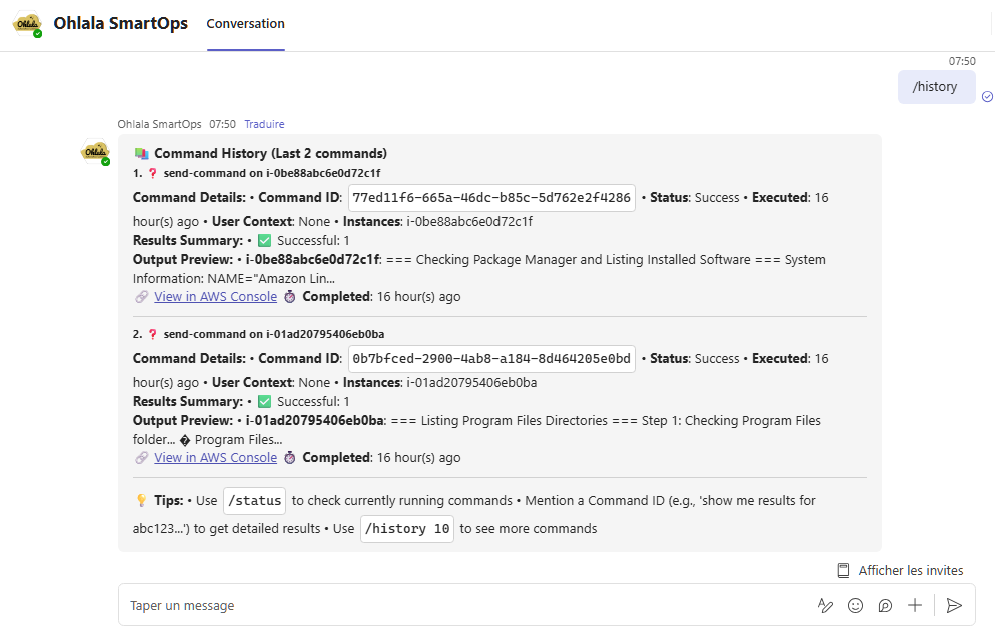
/token-usage
Purpose: Monitor Bedrock AI token usage and costs
Usage:
/token-usage
Response: Token usage analytics including:
- Current billing period usage
- Token consumption trends
- Cost breakdown by operation type
- Usage limits and quotas
- Optimization recommendations
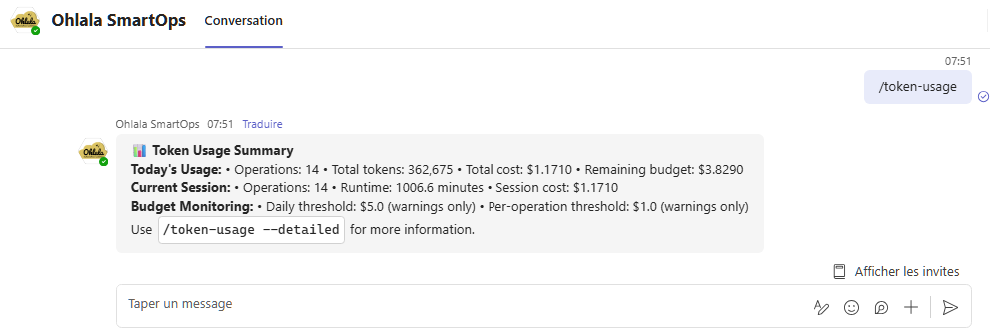
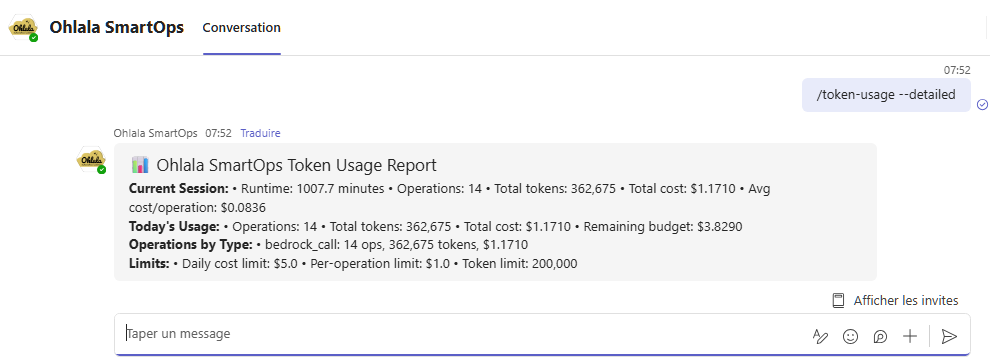
📝 Command Tips
Quick Access
- Type
/in Teams to see all available slash commands - Commands are case-insensitive:
/help=/HELP=/Help - Use Tab completion in Teams for faster command entry
Combining with Natural Language
You can follow slash commands with natural language for more specific requests:
/health show me only instances with high CPU usage
/instances filter by production environment
/help with cost optimization
Command Parameters
- Most commands work without parameters for overview information
- Add instance IDs for specific instance details:
/health i-1234567890abcdef0 - Use
/help [command]for detailed usage instructions
Command History
- Use ↑ (up arrow) in Teams to repeat recent commands
- All commands are logged for audit purposes
- Interactive cards maintain state for better user experience
🔍 Command Comparison
| Command | Speed | Detail Level | Best For |
|---|---|---|---|
/instances | ⚡ Fast | 📊 Interactive | Instance management |
"show me my instances" | 🐌 Slower | 📖 Conversational | Analysis & insights |
/health | ⚡ Fast | 📈 Dashboard | Health monitoring |
"which instances need attention?" | 🐌 Slower | 🔍 AI Analysis | Troubleshooting |
/status | ⚡ Fast | 📋 Current | Operation tracking |
🚨 Error Handling
Common Issues
Command not recognized:
Unknown command: /instaces
Did you mean: /instances?
Missing permissions:
❌ Insufficient AWS permissions for this operation
Contact your administrator to review IAM policies
Service unavailable:
⚠️ AWS services temporarily unavailable
Try again in a few moments or use /status for details
Recovery Steps
- Check spelling - Commands must be exact
- Verify AWS permissions - Commands require proper IAM roles
- Try
/status- Check if services are operational - Use
/help- See all available commands
📖 Next Steps
Learn More
- Natural Language Commands → - Conversational interactions
- Command Examples → - Real-world usage scenarios
- Troubleshooting → - Resolve common issues
Quick Start
Try these commands right now in Teams:
/help- See what’s available/instances- View your EC2 instances with interactive controls/health- Check instance health dashboard/rightsizing- Discover cost optimization opportunities"show me instances that need attention"- Try natural language
🔄 Advanced Usage
Command Workflows
Combine slash commands for powerful workflows:
1. /instances → Click instance → View health details
2. /health → Identify issues → Use natural language for troubleshooting
3. /rightsizing → Review recommendations → Ask for implementation help
4. /status → Monitor ongoing operations → /history for detailed results
Interactive Features
- Action Buttons: Most commands include interactive buttons for common actions
- Context Preservation: Commands remember your selections for follow-up questions
- Real-time Updates: Health and status information refreshes automatically
- Multi-language Support: Commands adapt to your Teams language preference
Need Help?
- 📧 Support: support@ohlala.cloud
- 📚 Full Documentation: Browse all docs
- 🎥 Video Tutorials: Command Examples Gallery ↗️